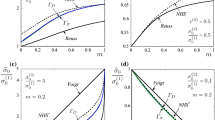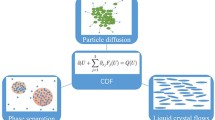Abstract
Following is an elaboration on D. G. B. Edelen’s (1972–1973) nonlinear generalization of the classical Rayleigh-Onsager dissipation potentials and the implications for the models of viscoplasticity. A brief derivation is given via standard vector calculus of Edelen’s potentials and the associated non-dissipative or “gyroscopic” forces and fluxes. It is also shown that certain extensions of Edelen’s formulae can be obtained by means of a recently proposed source-flux relation or “inverse divergence,” a generalization of the classical Gauss-Maxwell construct. The Legendre–Fenchel duality of Edelen’s potentials is explored, with important consequences for rate-independent friction or plasticity. The use of dissipation potentials serves to facilitate the development of viscoplastic constitutive equations, a point illustrated here by the special cases of Stokesian fluid-particle suspensions and granular media. In particular, we consider inhomogeneous systems with particle migration coupled to gradients in particle concentration, strain rate, and fabric. Employing a mixture-theoretic treatment of Stokesian suspensions, one is able to identify particle stress as the work conjugate of the global deformation of the particle phase. However, in contrast to past treatments, this stress is not assumed to be a privileged driving force for particle migration. A comparison is made with models based on extremal dissipation or entropy production. It is shown that such models yield the correct dissipative components of force or flux but generally fail to capture certain non-dissipative, but mechanically relevant components. The significance of Edelen’s gyroscopic forces and their relation to reactive constraints or other reversible couplings is touched upon. When gyroscopic terms are absent, one obtains a class of strongly dissipative or hyperdissipative materials whose quasi-static mechanics are governed by variational principles based on dissipation potential. This provides an interesting analog to elastostatic variational principles based on strain energy for hyperelastic materials and to the associated material instabilities arising from loss of convexity.
Similar content being viewed by others
References
Acosta G., Duràn R., Muschietti M.: Solutions of the divergence operator on John domains. Adv. Math. 206, 373–401 (2006)
Ball J.M.: Singularities and computation of minimizers for variational problems.. In: DeVore, R.A., Iserles, A., Endre, S. (eds) Foundations of Computational Mathematics, Volume 284 of London Mathematical Society Lecture Notes, pp. 1–19. Cambridge University Press, Cambridge (2001)
Bataille J., Edelen D., Kestin J.: Nonequilibrium thermodynamics of the nonlinear equations of chemical kinetics. J. Non Equil. Thermo. 3, 153–68 (1978)
Bataille J., Edelen D., Kestin J.: On the structuring of thermodynamic fluxes: a direct implementation of the dissipation inequality. Int. J. Eng. Sci. 17, 563–72 (1979)
Besson J.: Continuum models of ductile fracture: a review. Int. J. Damage Mech. 19, 3–52 (2010)
Collins I., Houlsby G.: Application of thermomechanical principles to the modelling of geotechnical materials. Proc. Roy. Soc. Lond. A. 453, 1975–2001 (1997)
Cowin S.C.: The relationship between the elasticity tensor and the fabric tensor. Mech. Mater. 4, 137–47 (1985)
Edelen D.G.B.: A nonlinear Onsager theory of irreversibility. Int. J. Eng. Sci. 10, 481–90 (1972)
Edelen D.G.B.: On the existence of symmetry relations and dissipation potentials. Arch. Ration. Mech. Anal. 51, 218–27 (1973)
Edelen D.G.B.: College Station Lectures on Thermodynamics. Texas A & M University, College Station (1993)
Edelen, D.G.B.: Applied exterior calculus. Dover Publications Inc., Mineola, NY, revised edition, (2005)
Edelen D.G.B.: Properties of an elementary class of fluids with nondissipative viscous stresses. Int. J. Eng. Sci. 15, 727–31 (1977)
Effros E.G.: A matrix convexity approach to some celebrated quantum inequalities. PNAS 106, 1006–08 (2009)
Eringen A.C.: Microcontinuum Field Theories, Volume I: Foundations and Solids. Springer, New York (1999)
Fang Z., Mammoli A., Brady J., et al.: Flow-aligned tensor models for suspension flows. Int. J. Multiph. Flow. 28, 137–66 (2002)
Freudenthal A., Geiringer H.: The mathematical theories of the inelastic continuum. In: Flügge, H. (eds) , Elasticity and Plasticity, Volume VI of Handbuch der Physik, pp. 229–432. Springer, Berlin (1958)
Gao D.Y.: Duality Principles in Nonconvex Systems: Theory, Methods, and Applications, Volume 39. Kluwer Academic Publishers, Dordrect (2000)
Goddard J.D.: Material instability in complex fluids. Ann. Rev. Fluid Mech. 35, 113–33 (2003)
Goddard, J.D.: A weakly nonlocal anisotropic fluid model for inhomogeneous Stokesian suspensions. Phys. Fluids, 20, 040601/1–01/16, (2008)
Goddard J.D.: Parametric hypoplasticity as continuum model for granular media: from Stokesium to Mohr-Coulombium and beyond. Gran. Mat. 12, 145–50 (2010)
Goddard J.D.: A note on Eringen’s moment balances. Int. J. Eng. Sci. 49, 1486–93 (2011)
Goddard J.D.: On the thermoelectricity of W. Thomson: towards a theory of thermoelastic conductors. J. Elast. 104, 267–80 (2011)
Green A.E., Naghdi P.M., Trapp J.A.: Thermodynamics of a continuum with internal constraints. Int. J. Eng. Sci. 8, 891–908 (1970)
Gurtin M.E.: Continuum thermodynamics. In: Nemat-Nasser, S. (eds) Mechanics Today, pp. 168–213. Pergamon, New York (1972)
Hill R.: A variational principle of maximum plastic work in classical plasticity. QJMAM 1, 18–28 (1948)
Hill R.: The Mathematical Theory of Plasticity. Clarendon Press, Oxford (1950)
Hill R., Rice J.: Elastic potentials and the structure of inelastic constitutive laws. SIAM J. Appl. Math. 25, 448–61 (1973)
Johnson M.W.: On variational principles for non-Newtonian fluids. Trans. Soc. Rheol. 5, 9–21 (1961)
Keller J., Rubenfeld L., Molyneux J.: Extremum principles for slow viscous flows with applications to suspensions. J. Fluid Mech. 30, 97–125 (1967)
Lehoucq R., Silling S.: Force flux and the peridynamic stress tensor. J. Mech. Phys. Solids 56, 1566–1577 (2008)
Lighthill M.J.: Introduction to Fourier analysis and Generalised Functions. Cambridge Monographs on Mechanics and Applied Mathematics. University Press, Cambridge (1958)
Lippmann H.: Eine Cosserat-Theorie des plastischen Fließens. Acta Mech. 8, 255–284 (1969)
Lippmann H.: Extremum and Variational Principles in Mechanics, Volume 54 of International Centre for Mechanical Sciences Courses and Lectures. Springer, New York (1972)
Maréchal P.: On a functional operation generating convex functions, part 2: Algebraic properties. J. Optim. Theor. Appl. 126, 357–66 (2005)
Maugin G.A.: The Thermomechanics of Plasticity and Fracture. Cambridge Texts in Applied Mathematics. Cambridge University Press, Cambridge (1992)
Mohan S., Rao K., Nott P.: A frictional Cosserat model for the slow shearing of granular materials. J. Fluid Mech. 457, 377–409 (2002)
Moreau J.J.: Sur les lois de frottement, de plasticité et de viscosité. CR Acad. Sci. 271, 608–11 (1970)
Nemat-Nasser S.: Plasticity: A Treatise on Finite Deformation of Heterogeneous Inelastic Materials. Cambridge University Press, Cambridge (2004)
Ostoja-Starzewski M., Zubelewicz A.: Powerless fluxes and forces, and change of scale in irreversible thermodynamics. J. Phys. A. 44, 335002 (2011)
Panagiotopoulos P.D.: Non-convex superpotentials in the sense of F.H. Clarke and applications. Mech. Res. Commun. 8, 335–40 (1981)
Prager W.: On ideal locking materials. Trans. Soc. Rheol. 1, 169–75 (1957)
Rajagopal K., Tao L.: Mechanics of Mixtures, vol. 35 of Series on Advances in Mathematics for Applied Sciences. World Scientific, River Edge (1995)
Rajagopal K.R., Srinivasa A.R.: A thermodynamic framework for rate type fluid models. J. Non-Newtonian Fluid Mech. 88, 207–27 (2000)
Regirer S.A., Rutkevich I.M.: Certain singularities of the hydrodynamic equations of non-Newtonian media. J. Appl. Math. Mech. 32, 62–66 (1968)
Segev R., De Botton G.: On the consistency conditions for force systems. Int. J. Non. Lin. Mech. 26, 47–59 (1991)
Sun J., Sundaresan S.: A constitutive model with microstructure evolution for flow of rate-independent granular materials. J. Fluid Mech. 682, 590–616 (2011)
Wikipedia.: Convex Conjugate—Wikipedia the free encyclopedia, 2011. http://en.wikipedia.org/wiki/Convex_conjugate
Yapici K., Powell R.L., Phillips R.J.: Particle migration and suspension structure in steady and oscillatory plane Poiseuille flow. Phys. Fluids 21, 053302–16 (2009)
Ziegler, H.: Some extremum principles in irreversible thermodynamics with application to continuum mechanics. In Progress in Solid Mechanics, pp. 93–192. J. Wiley; North-Holland Pub. Co., New York; Amsterdam, (1963)
Ziegler H.: Discussion of some objections to thermomechanical orthogonality. Arch. Appl. Mech. 50, 149–64 (1981)
Ziegler H.: An Introduction to Thermomechanics, volume 21 of North-Holland Series in Applied Mathematics and Mechanics. Elsevier Science, Amsterdam (1983)
Ziegler H., Wehrli C.: On a principle of maximal rate of entropy production. J. Non. Equil. Thermo. 12, 229–44 (1987)
Ziegler H. , Yu L.: Incompressible Reiner-Rivlin fluids obeying the orthogonality condition. Arch. Appl. Mech. 41, 89–99 (1972)
Author information
Authors and Affiliations
Corresponding author
Rights and permissions
About this article
Cite this article
Goddard, J.D. Edelen’s dissipation potentials and the visco-plasticity of particulate media. Acta Mech 225, 2239–2259 (2014). https://doi.org/10.1007/s00707-014-1123-3
Received:
Revised:
Published:
Issue Date:
DOI: https://doi.org/10.1007/s00707-014-1123-3




